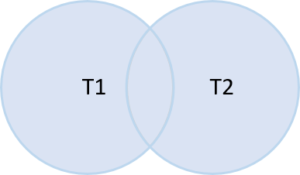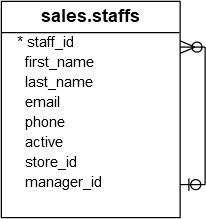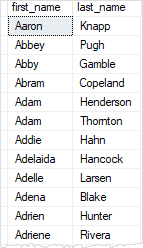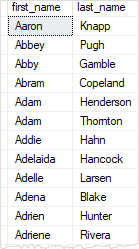Summary: in this tutorial, you will learn how to use the SQL Server UNION to combine the results of two or more queries into a single result set.
Introduction to SQL Server UNION operator
SQL Server UNION is one of the set operations that allow you to combine results of two SELECT statements into a single result set which includes all the rows that belong to the SELECT statements in the union.
The following illustrates the syntax of the SQL Server UNION:
query_1
UNION
query_2
Code language: SQL (Structured Query Language) (sql)The following are requirements for the queries in the syntax above:
- The number and the order of the columns must be the same in both queries.
- The data types of the corresponding columns must be the same or compatible.
The following Venn diagram illustrates how the result set of the T1 table unions with the result set of the T2 table:

UNION vs. UNION ALL
By default, the UNION operator removes all duplicate rows from the result sets. However, if you want to retain the duplicate rows, you need to specify the ALL keyword is explicitly as shown below:
query_1
UNION ALL
query_2
Code language: SQL (Structured Query Language) (sql)In other words, the UNION operator removes the duplicate rows while the UNION ALL operator includes the duplicate rows in the final result set.
UNION vs. JOIN
The join such as INNER JOIN or LEFT JOIN combines columns from two tables while the UNION combines rows from two queries.
In other words, join appends the result sets horizontally while union appends the result set vertically.
The following picture illustrates the main difference between UNION and JOIN:

SQL Server UNION examples
See the following staffs and customers tables from the sample database:


UNION and UNION ALL examples
The following example combines names of staff and customers into a single list:
SELECT
first_name,
last_name
FROM
sales.staffs
UNION
SELECT
first_name,
last_name
FROM
sales.customers;
Code language: SQL (Structured Query Language) (sql)
It returns 1,454 rows.
The staffs table has 10 rows and the customers table has 1,445 rows as shown in the following queries:
SELECT
COUNT (*)
FROM
sales.staffs;
-- 10
SELECT
COUNT (*)
FROM
sales.customers;
-- 1454
Code language: SQL (Structured Query Language) (sql)Because the result set of the union returns only 1,454 rows, it means that one duplicate row was removed.
To include the duplicate row, you use the UNION ALL as shown in the following query:
SELECT
first_name,
last_name
FROM
sales.staffs
UNION ALL
SELECT
first_name,
last_name
FROM
sales.customers;
Code language: SQL (Structured Query Language) (sql)The query returns 1,455 rows as expected.
UNION and ORDER BY example
To sort the result set returned by the UNION operator, you place the ORDER BY clause in the last query as follows:
SELECT
select_list
FROM
table_1
UNION
SELECT
select_list
FROM
table_2
ORDER BY
order_list;
Code language: SQL (Structured Query Language) (sql)For example, to sort the first names and last names of customers and staff, you use the following query:
SELECT
first_name,
last_name
FROM
sales.staffs
UNION ALL
SELECT
first_name,
last_name
FROM
sales.customers
ORDER BY
first_name,
last_name;
Code language: SQL (Structured Query Language) (sql)
In this tutorial, you have learned how to use the SQL Server UNION to combine rows from multiple queries into a single result set.